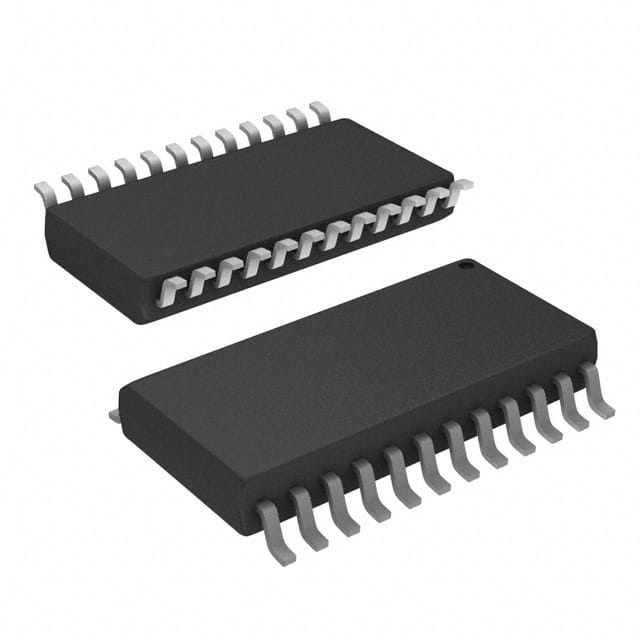PCF8575DWG4
Product Overview
- Category: Integrated Circuit (IC)
- Use: I/O Expander
- Characteristics: High-speed, 16-bit remote I/O expander for I2C-bus applications
- Package: SOIC (Small Outline Integrated Circuit)
- Essence: The PCF8575DWG4 is a versatile I/O expander that provides easy interfacing between microcontrollers and various peripheral devices.
- Packaging/Quantity: Available in reels of 2500 units
Specifications
- Supply Voltage: 2.3V to 5.5V
- I/O Voltage Level: 1.8V to VDD
- Maximum I/O Current: ±25mA
- Operating Temperature Range: -40°C to +85°C
- I2C-bus Interface: Compatible with I2C Fast-mode and Standard-mode
Detailed Pin Configuration
The PCF8575DWG4 has a total of 24 pins, which are assigned as follows:
- A0: Address Input Bit 0
- A1: Address Input Bit 1
- A2: Address Input Bit 2
- P0-P7: Bidirectional I/O Ports 0 to 7
- INT: Interrupt Output
- SDA: Serial Data Line
- SCL: Serial Clock Line
- GND: Ground
- VDD: Supply Voltage
Functional Features
- 16-bit remote bidirectional I/O port
- I2C-bus interface allows easy connection with microcontrollers
- Individual direction control for each I/O pin
- Interrupt output for efficient event notification
- Low standby current consumption
- Noise filter on the SDA/SCL inputs for improved performance in noisy environments
Advantages and Disadvantages
Advantages
- Versatile I/O expander suitable for a wide range of applications
- Easy integration with microcontrollers through the I2C-bus interface
- Individual pin direction control provides flexibility in design
- Low power consumption in standby mode
Disadvantages
- Limited to 16-bit I/O expansion, may not be sufficient for complex systems requiring more I/O pins
- Requires additional components (microcontroller, I2C-bus) for complete functionality
Working Principles
The PCF8575DWG4 operates as an I/O expander by providing 16 bidirectional I/O ports that can be controlled through the I2C-bus interface. It communicates with a microcontroller or other devices using the I2C protocol, allowing for easy expansion of I/O capabilities.
By configuring the direction of each individual I/O pin, the PCF8575DWG4 can be used to interface with various peripheral devices such as sensors, switches, LEDs, and displays. The interrupt output feature enables efficient event notification, reducing the need for continuous polling of the I/O ports.
Detailed Application Field Plans
The PCF8575DWG4 finds applications in various fields, including but not limited to:
- Industrial Automation: Control and monitoring of sensors, actuators, and other industrial equipment.
- Home Automation: Integration with smart home systems for controlling lights, appliances, and security devices.
- Automotive Electronics: Interface with vehicle subsystems, such as dashboard displays, climate control, and infotainment systems.
- Consumer Electronics: Expansion of I/O capabilities in devices like gaming consoles, audio systems, and home entertainment systems.
Detailed and Complete Alternative Models
- MCP23017: Similar 16-bit I/O expander with I2C-bus interface, offered by Microchip Technology Inc.
- TCA9539: 16-bit I/O expander with I2C-bus/SMBus interface, provided by Texas Instruments.
- MAX7313: 16-bit I/O port expander with serial interface, manufactured by Maxim Integrated.
These alternative models offer similar functionality and can be considered as alternatives to the PCF8575DWG4 based on specific requirements and availability.
Word count: 525 words
Lista 10 Vanliga frågor och svar relaterade till tillämpningen av PCF8575DWG4 i tekniska lösningar
Sure! Here are 10 common questions and answers related to the application of PCF8575DWG4 in technical solutions:
Question: What is PCF8575DWG4?
- Answer: PCF8575DWG4 is an I/O expander integrated circuit (IC) that provides additional input/output ports for microcontrollers or other digital devices.Question: How many I/O ports does PCF8575DWG4 provide?
- Answer: PCF8575DWG4 provides a total of 16 I/O ports, which can be configured as either inputs or outputs.Question: What is the voltage range supported by PCF8575DWG4?
- Answer: PCF8575DWG4 supports a voltage range of 2.3V to 5.5V, making it compatible with a wide range of microcontrollers and digital devices.Question: Can PCF8575DWG4 be used with both 3.3V and 5V microcontrollers?
- Answer: Yes, PCF8575DWG4 is designed to work with both 3.3V and 5V microcontrollers, thanks to its wide voltage range support.Question: How can PCF8575DWG4 be connected to a microcontroller?
- Answer: PCF8575DWG4 can be connected to a microcontroller using the I2C bus interface, which requires only two wires for communication.Question: Can PCF8575DWG4 be used to drive LEDs or other high-power devices directly?
- Answer: No, PCF8575DWG4 is not designed to drive high-power devices directly. It is recommended to use external drivers or transistors for such applications.Question: Can PCF8575DWG4 be used for both input and output operations simultaneously?
- Answer: Yes, PCF8575DWG4 supports bidirectional I/O operations, allowing it to be used for both input and output functions at the same time.Question: What is the maximum current that can be sourced or sunk by each I/O port of PCF8575DWG4?
- Answer: Each I/O port of PCF8575DWG4 can source or sink a maximum current of 25mA.Question: Is PCF8575DWG4 suitable for battery-powered applications?
- Answer: Yes, PCF8575DWG4 is suitable for battery-powered applications due to its low power consumption and wide voltage range support.Question: Are there any libraries or example codes available for programming PCF8575DWG4?
- Answer: Yes, many microcontroller platforms have libraries and example codes available for programming PCF8575DWG4, making it easier to integrate into your project.
Please note that these answers are general and may vary depending on specific application requirements.


